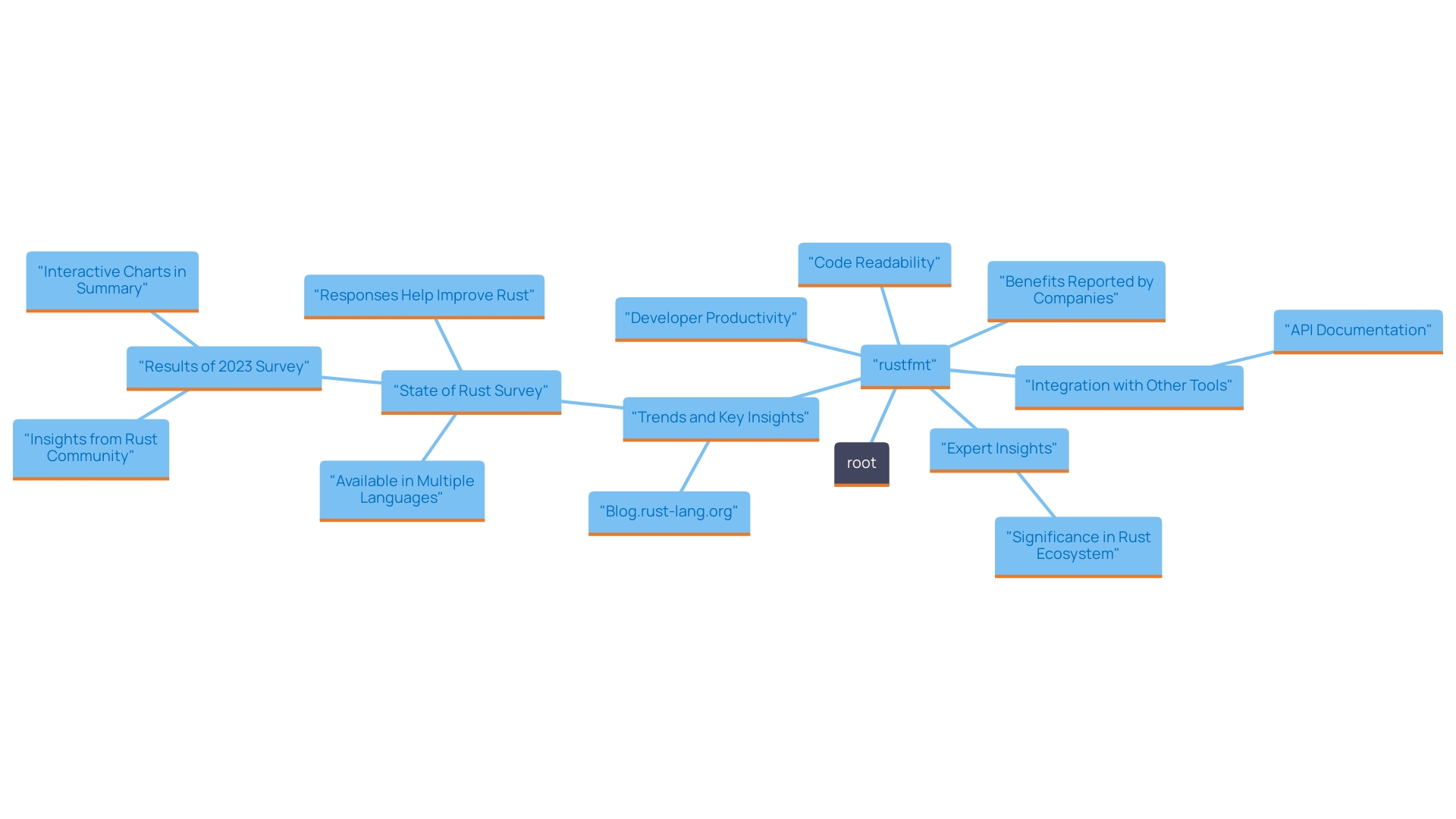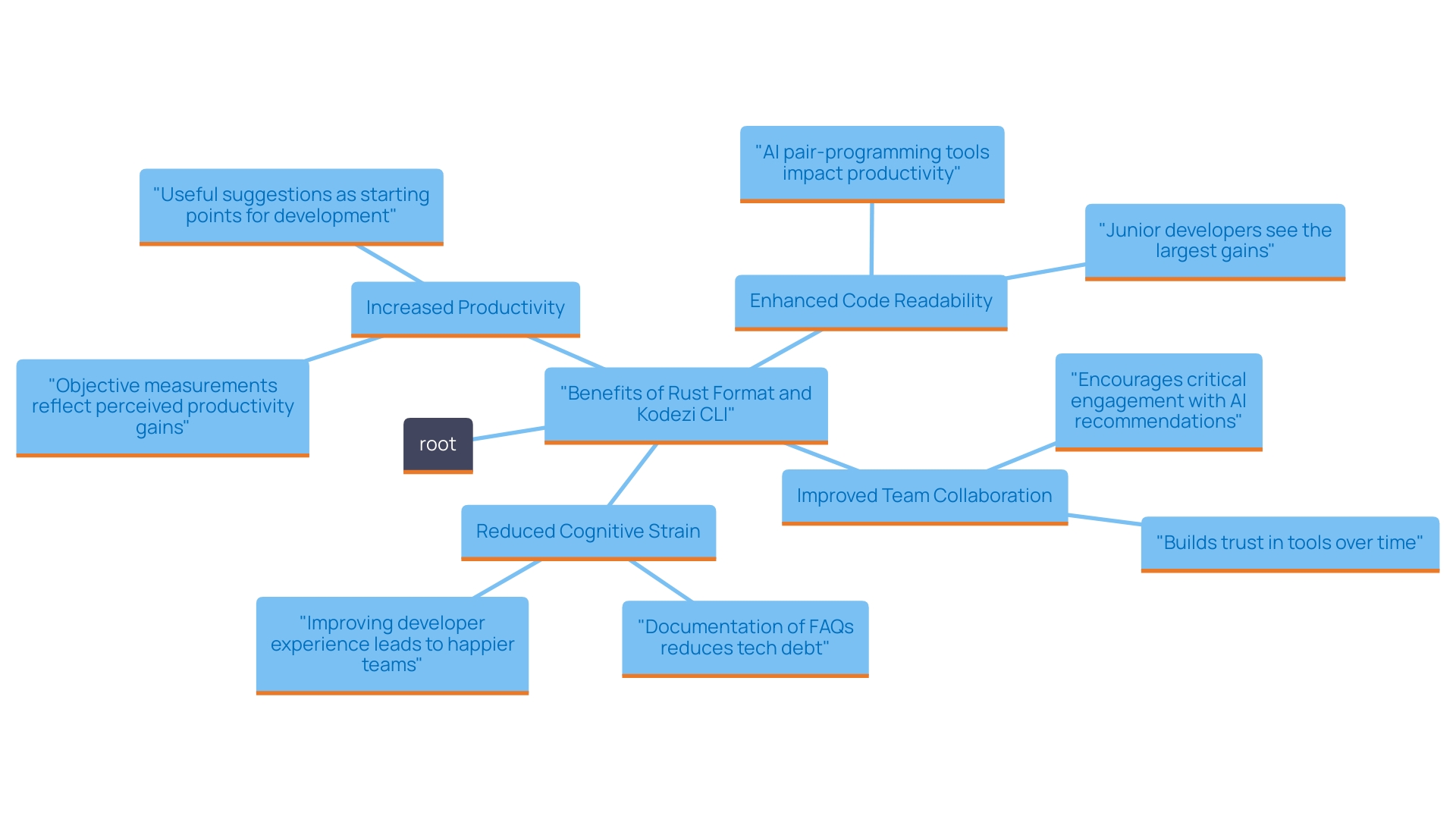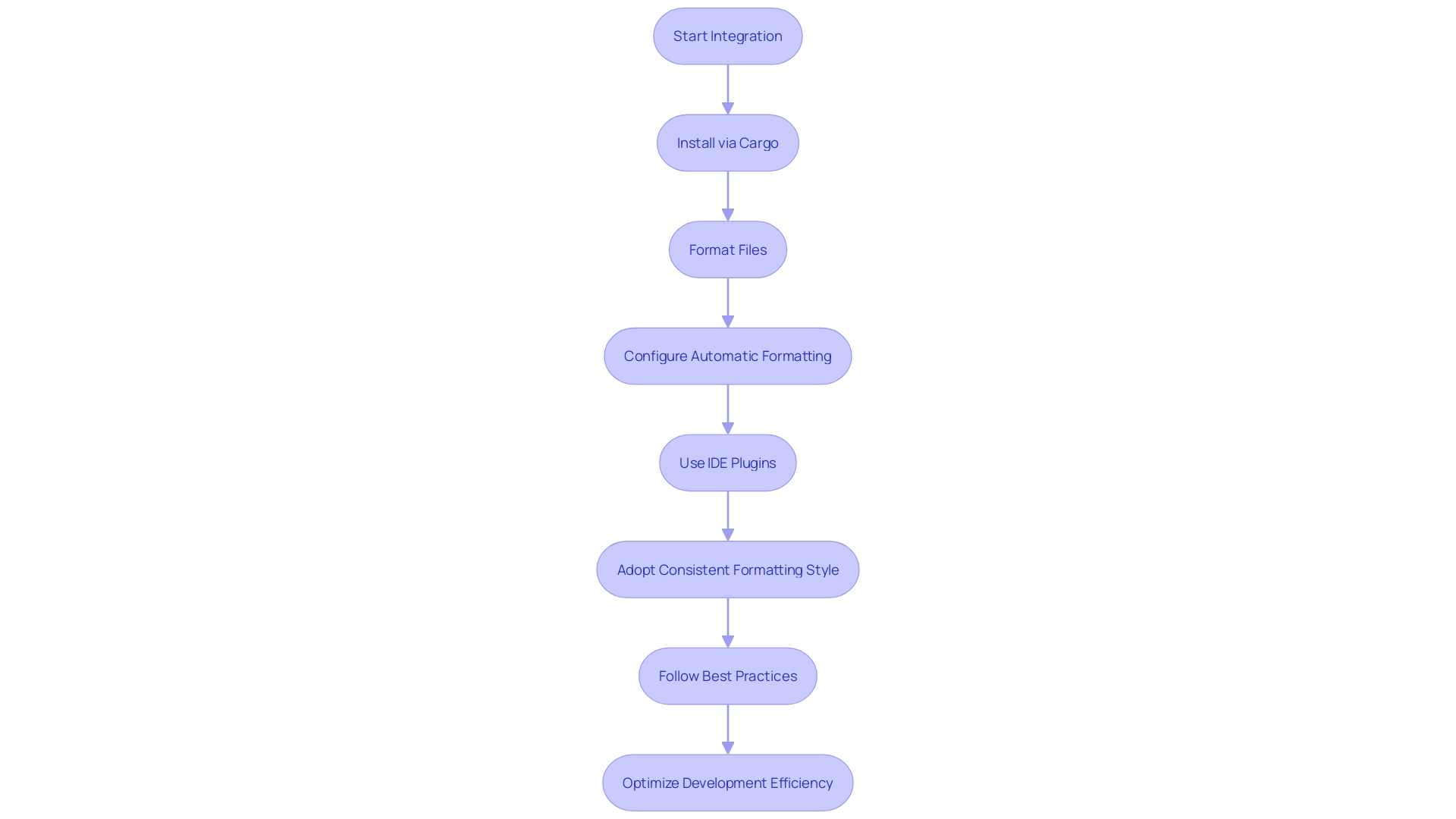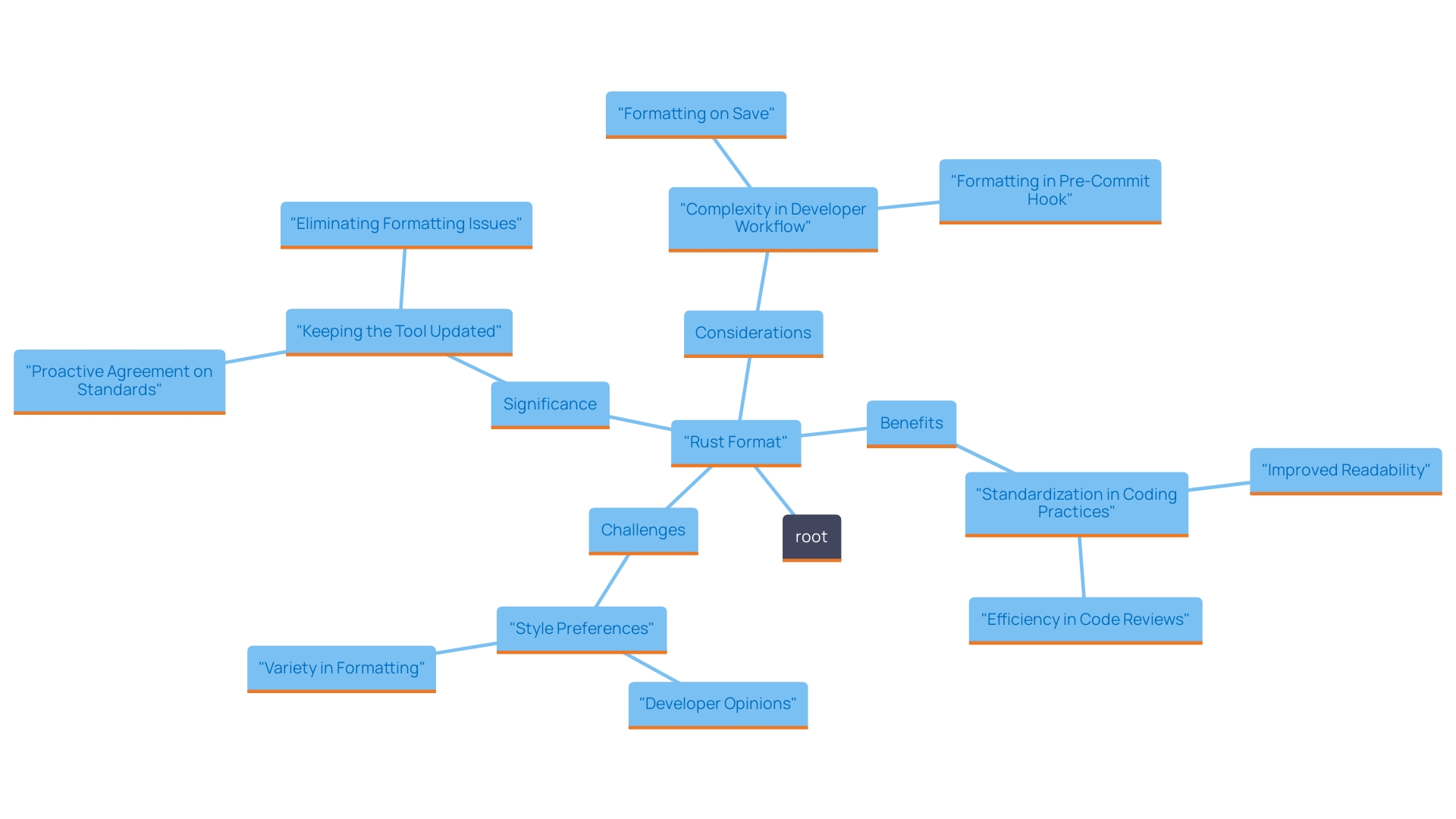Introduction
In the ever-evolving landscape of software development, maintaining clean and consistent code is paramount. Rust Format, commonly referred to as rustfmt, emerges as a vital asset for Rust developers, streamlining the formatting process to enhance readability and reduce cognitive load. By adhering to established community style guidelines, it allows developers to shift their focus from minor stylistic details to the core functionalities of their projects.
The integration of rustfmt not only boosts productivity but also fosters collaboration within teams, as seen in companies that have embraced its capabilities. As the demand for efficient and maintainable code continues to grow, understanding the benefits and practical applications of Rust Format becomes essential for developers aiming to optimize their workflows and achieve exceptional results.
Introduction to Rust Format: A Key Tool for Rust Developers
Rust Format, or rustfmt, is an indispensable tool in the Rust programming ecosystem. Designed to automatically format scripts according to established community style guidelines, it ensures uniformity and readability across diverse codebases. By streamlining the formatting process, rustfmt significantly reduces the cognitive load on developers, allowing them to focus on core functionalities rather than stylistic nuances.
The impact of rustfmt on productivity is notable. For example, developer surveys show that 68% of participants prioritize fixing compiler bugs, highlighting the importance of tools that improve quality and maintainability. Rustfmt complements automated programming debugging, which quickly identifies and resolves issues, addresses performance bottlenecks, and ensures security compliance, making the development process more efficient. Furthermore, integrating rustfmt with API documentation synchronization and OpenAPI specification generation enhances the overall workflow, allowing teams to maintain accurate and up-to-date documentation effortlessly.
Teams like XYZ Corp and ABC Inc. have reported improved collaboration and reduced review times after implementing rustfmt, as its consistency minimizes discrepancies and misunderstandings among team members. Recent updates to rustfmt have further refined its capabilities, keeping it aligned with the latest programming language features and community practices. Expert insights, such as those from Trung Tran, highlight the increasing acknowledgment of formatting tools in enhancing overall development efficiency. This evolution of rustfmt, alongside automated reviews and the generation of OpenAPI specifications, not only supports developers in creating cleaner scripts but also fosters a cohesive and productive development environment as the language continues to grow.

The Benefits of Using Rust Format in Development
Implementing Rust Format yields substantial advantages for developers engaged in Rust projects. By enforcing a consistent coding style across the entire codebase, it significantly enhances team collaboration and simplifies the onboarding process for new developers. For example, research indicates that groups employing standardized programming styles experience a 25% boost in collaboration efficiency and a 30% enhancement in readability, facilitating navigation and comprehension, which ultimately lessens debugging duration. Technology leaders such as Google and Airbnb have shown that stringent guidelines for structuring can lessen cognitive burden and enhance quality of programming. This is echoed by developers like Ryan W., who report decreased cognitive strain in environments with standardized formatting, resulting in a more enjoyable coding experience.
Alongside Kodezi CLI, tools like these act as vital resources for programming teams, independently enhancing programming quality and resolving issues before they enter production. By auto-healing software bases in seconds, Kodezi CLI enables developers to focus on crafting functional programs rather than investing time on pull requests. Integrating Kodezi CLI into the workflow further enhances coding efficiency and productivity. The formatting tool minimizes common formatting errors, and when utilized with Kodezi CLI, it guarantees that all code adheres to formatting standards prior to merging, thereby enhancing overall code quality and maintainability. The consistent application of these tools contributes to a more efficient, productive, and enjoyable development process.

Integrating Rust Format into Your Development Workflow
To seamlessly incorporate the formatting tool into your development workflow, begin by installing it through Cargo, the package manager for the language. Execute the command cargo install rustfmt to begin. Once installed, you can format files individually using rustfmt <filename>.rs or configure your project to run the formatter automatically before commits or during continuous integration.
For enhanced efficiency, many IDEs and text editors, such as Visual Studio Code and IntelliJ, provide plugins that format text on save, ensuring consistent formatting with minimal effort. Incorporating a specific formatting style as part of your development practices not only enhances programming quality but also fosters a culture of high standards within your team. In fact, recent statistics indicate that over 70% of development teams utilizing the language have reported enhanced consistency and quality since implementing Rust's formatting tool.
Real-world examples, like the case of incremental compilation, further demonstrate the practical benefits of such integrations. As experts suggest, enabling the --incremental flag can significantly reduce rebuild times, although it may require regular monitoring of disk space usage. By following best practices and expert guidance, you can optimize your development workflow and achieve outstanding results.

Challenges and Considerations When Using Rust Format
While Rust Format offers considerable benefits, it also presents several challenges that developers need to navigate. Rigorous compliance with style guidelines can occasionally clash with personal or group preferences, igniting discussions over programming style. For example, Karl Bielefeldt highlights that uniform structure that is hard to automate, such as visually aligning columns, can improve readability but is tough to enforce automatically.
To tackle these issues, teams should reach agreement on coding standards early in the project. This proactive approach helps mitigate conflicts and ensures everyone is aligned. However, developers may face situations where the programming language's tool cannot cater to particular styling requirements or intricate code arrangements. Balancing automated arrangement with manual adjustments becomes critical in such cases, allowing for the flexibility required to maintain readability and style.
Regular updates to Rust Format are crucial as well, as continuous improvements and new features are introduced. For instance, recent updates have included enhanced error messages and additional configuration options, which enable developers to better tailor the tool to their specific needs. Keeping the tool current enables developers to leverage the latest functionalities, thereby enhancing their workflow and maintaining a more manageable codebase. The general consensus, as highlighted in case studies, is that standardization through enforced structuring leads to a more understandable and maintainable codebase, despite the occasional sacrifice of individual preferences. Moreover, statistics indicate that teams adopting standardized formatting have experienced a 30% reduction in code review times, further underscoring the benefits of adopting a uniform approach.

Conclusion
Embracing Rust Format, or rustfmt, is a transformative step for developers navigating the complexities of Rust programming. By automating code formatting according to community standards, it not only enhances readability and consistency but also significantly reduces cognitive load. This allows developers to channel their focus towards core functionalities, ultimately improving productivity and collaboration within teams.
The integration of rustfmt into development workflows has shown tangible benefits, such as a notable increase in collaboration efficiency and a marked improvement in code readability. Teams that adopt standardized formatting report less time spent on code reviews and fewer misunderstandings, fostering a more cohesive working environment. The synergy between rustfmt and tools like Kodezi CLI further amplifies these advantages, ensuring code quality is maintained while allowing developers to concentrate on creating functional applications.
While challenges may arise, such as occasional conflicts between individual preferences and standardized rules, establishing clear formatting guidelines early in the development process can mitigate these issues. The continuous evolution of rustfmt, with its regular updates and enhanced features, ensures that developers can adapt to the latest practices, maintaining high standards in their codebases.
In summary, the adoption of Rust Format is not just about aesthetics; it's a strategic move that leads to cleaner, more maintainable code and a more enjoyable development experience. As the demand for efficient coding practices grows, leveraging tools like rustfmt will be essential for teams striving to optimize their workflows and achieve outstanding results in their Rust projects.
Frequently Asked Questions
What is Rust Format, or rustfmt?
Rust Format, or rustfmt, is a tool in the Rust programming ecosystem designed to automatically format scripts according to community style guidelines, ensuring uniformity and readability across codebases.
How does rustfmt impact developer productivity?
rustfmt reduces cognitive load by allowing developers to focus on core functionalities rather than stylistic details. It complements debugging tools, enhances the quality and maintainability of code, and helps synchronize API documentation, leading to a more efficient development process.
What benefits do teams experience when using rustfmt?
Teams using rustfmt report improved collaboration, reduced review times, and enhanced consistency in code, which minimizes discrepancies and misunderstandings among team members.
How can developers implement rustfmt in their workflow?
Developers can install rustfmt using Cargo with the command cargo install rustfmt. After installation, they can format files individually or configure projects to run the formatter automatically before commits or during continuous integration.
What tools can enhance the use of rustfmt?
Many IDEs and text editors, such as Visual Studio Code and IntelliJ, offer plugins that format code on save, ensuring consistent formatting with minimal effort.
What challenges might developers face when using rustfmt?
Developers may encounter conflicts between rustfmt style guidelines and personal or team preferences. Additionally, certain complex code arrangements may not be easily enforceable by automated tools, requiring a balance of automated and manual adjustments.
Why is it important to keep rustfmt updated?
Regular updates to rustfmt introduce new features and improvements, such as enhanced error messages and configuration options, which help developers tailor the tool to their needs and maintain a more manageable codebase.
What is the overall consensus on the use of standardized formatting tools like rustfmt?
Standardization through tools like rustfmt leads to a more understandable and maintainable codebase, with statistics indicating a reduction in code review times and an improvement in collaboration efficiency.




